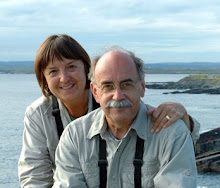A bit of summing up…
All things considered our tour went well. No one ever likes long travel days to and from destinations. Specially flying anywhere these days. Air travel for us has become a necessary evil. We also seemed to have had a lot of “bus time” this trip compared to the last one. But if one is to experience as much of an area as possible in a compressed amount of time, travel is required. Road conditions seemed to be the biggest bugaboo: construction delays and occasional rockslides. Even with the best of roads, twisting, curving roads in mountainous regions are never traveled quickly. Having read a few Tropical Birding trip reports from other years, road conditions could have been a lot worse. We were never prevented from getting to where we needed to be.
Physically speaking, this trip seemed easier on the body than the 2008 tour. Were we in better shape for this trip? Hardly. We just didn’t have to deal with as much high elevation and the trails, while at times challenging, didn’t seem to be as taxing.
Accommodations in the beginning of the trip were a bit of a jolt compared to other tours. However we always had a dry roof over our heads and we never felt unsafe. Southern Ecuador isn’t as established for ecotourism as is the north. And psychologically, just imagine taking our tour itinerary in reverse and having Macará wind up at the end! In the end it all had to do with our expectations and how we managed them. Truth be known, some of the early overnights and meals will likely wind up being tall tale fodder for many years to come.
Our group dynamic was a good mix. No, make that a great mix. Everyone brought their individual brand of humor and perspective. And it helped that we had José again as our guide which provided continuity from 2008. Even when he remembered who we were from our last trip! His ability to pull birds out of seemingly thin air (or thick jungle) was nothing short of amazing. An added bonus was having Niko with us once more. He was superb. Anyone who has traveled in areas with challenging road conditions appreciated his skill and care for our safety. And of course his never-ending smiles.
As always it was a pleasure to be birding again with good friend Richard Garrigues. While José was our principle guide, Richard’s ornithological and natural history expertise essentially gave us two guides for the price of one! And besides, he's just a great all around guy!
As for the birds we did well. Not quite the count we had in 2008 but each trip is different. Extensive bus time may have cut down on the numbers a bit but the weather for the most part was very cooperative. There were only a few days I can recall when the weather had a noticeable negative impact on birding. But that's what umbrellas and rain gear are for, yes?
It's a given that not everyone on a birding trip will see every bird. But José made every effort for us to see as many as possible. Sometimes it was simply a matter of being at the right spot at the right time or getting on a bird before it disappeared. At best, jungle birding is always a challenge.
Overall the group saw or heard 508 species. Many new birds for Carol and me. I will shortly send out a file listing all the birds on the tour. Personally I picked up 148 life birds and my Ecuador country list now stands at 749. As for our memories associated with so many of the bird sightings? That list is endless.
Where are we headed next? Good question. There is certainly no lack of destinations. Carol has been in contact with Tropical Birding about Columbia, which is just now opening up. Peru is a place that’s been on our radar for a while. There has also been some talk of birding Brazil. Even a possible return to northern Ecuador has been discussed.
We’re committed to Costa Rica in 2011 but being retired we are not now necessarily restricted to one trip per year. Or for that matter, traveling only in the winter months. There are compelling reasons for doing a Peru trip in July when the birding weather seems to be at its best. In the end it all boils down to time and money and maximizing both.
A caveat: This journal reflects our best recollection of how things unfolded. It is by no means all inclusive. Of course everyone will have their own recollections. Hopefully the journal will jog some of them. I know some of you took copious notes so by all means please let us know if there are glaring errors in timetable of events, the bird count, etc. Oh, yeah - and I'm still waiting for more photos...
Thanks to all of you for making our trip so pleasurable!




